2017 CADILLAC ESCALADE child restraint
[x] Cancel search: child restraintPage 94 of 354
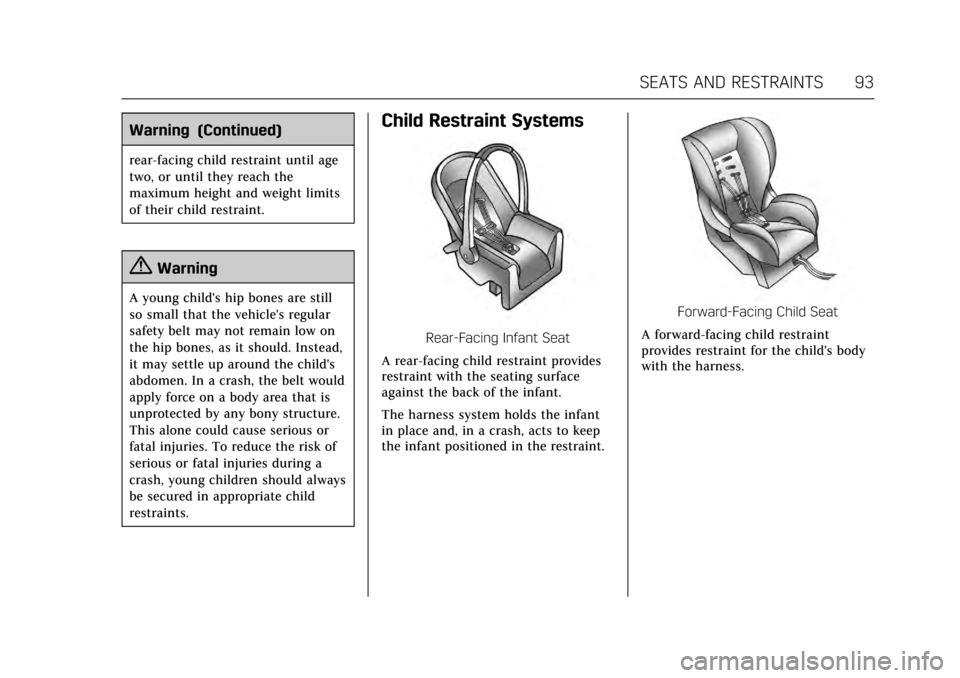
Cadillac Escalade Owner Manual (GMNA-Localizing-MidEast-10293077) -
2017 - crc - 8/24/16
SEATS AND RESTRAINTS 93
Warning (Continued)
rear-facing child restraint until age
two, or until they reach the
maximum height and weight limits
of their child restraint.
{Warning
A young child's hip bones are still
so small that the vehicle's regular
safety belt may not remain low on
the hip bones, as it should. Instead,
it may settle up around the child's
abdomen. In a crash, the belt would
apply force on a body area that is
unprotected by any bony structure.
This alone could cause serious or
fatal injuries. To reduce the risk of
serious or fatal injuries during a
crash, young children should always
be secured in appropriate child
restraints.
Child Restraint Systems
Rear-Facing Infant Seat
A rear-facing child restraint provides
restraint with the seating surface
against the back of the infant.
The harness system holds the infant
in place and, in a crash, acts to keep
the infant positioned in the restraint.
Forward-Facing Child Seat
A forward-facing child restraint
provides restraint for the child's body
with the harness.
Page 95 of 354
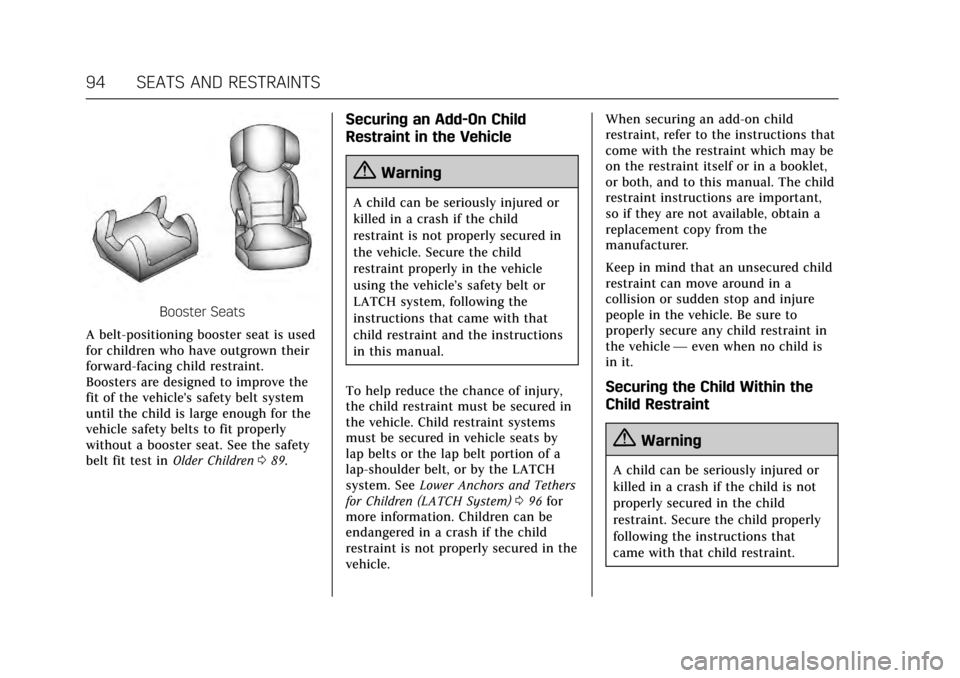
Cadillac Escalade Owner Manual (GMNA-Localizing-MidEast-10293077) -
2017 - crc - 8/24/16
94 SEATS AND RESTRAINTS
Booster Seats
A belt-positioning booster seat is used
for children who have outgrown their
forward-facing child restraint.
Boosters are designed to improve the
fit of the vehicle's safety belt system
until the child is large enough for the
vehicle safety belts to fit properly
without a booster seat. See the safety
belt fit test in Older Children089.
Securing an Add-On Child
Restraint in the Vehicle
{Warning
A child can be seriously injured or
killed in a crash if the child
restraint is not properly secured in
the vehicle. Secure the child
restraint properly in the vehicle
using the vehicle’s safety belt or
LATCH system, following the
instructions that came with that
child restraint and the instructions
in this manual.
To help reduce the chance of injury,
the child restraint must be secured in
the vehicle. Child restraint systems
must be secured in vehicle seats by
lap belts or the lap belt portion of a
lap-shoulder belt, or by the LATCH
system. See Lower Anchors and Tethers
for Children (LATCH System) 096 for
more information. Children can be
endangered in a crash if the child
restraint is not properly secured in the
vehicle. When securing an add-on child
restraint, refer to the instructions that
come with the restraint which may be
on the restraint itself or in a booklet,
or both, and to this manual. The child
restraint instructions are important,
so if they are not available, obtain a
replacement copy from the
manufacturer.
Keep in mind that an unsecured child
restraint can move around in a
collision or sudden stop and injure
people in the vehicle. Be sure to
properly secure any child restraint in
the vehicle
—even when no child is
in it.
Securing the Child Within the
Child Restraint
{Warning
A child can be seriously injured or
killed in a crash if the child is not
properly secured in the child
restraint. Secure the child properly
following the instructions that
came with that child restraint.
Page 96 of 354
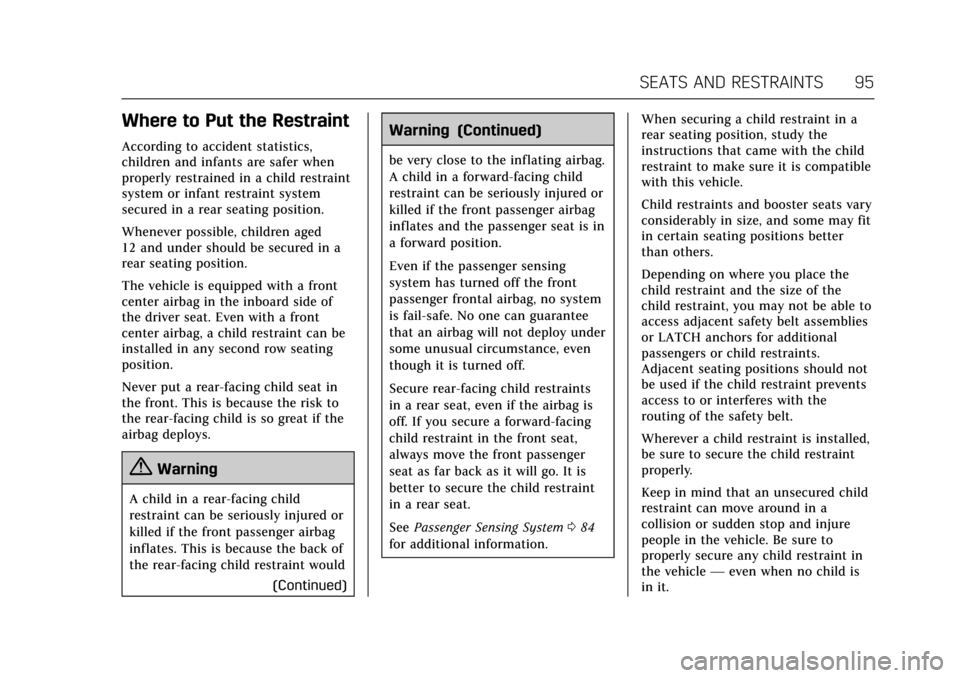
Cadillac Escalade Owner Manual (GMNA-Localizing-MidEast-10293077) -
2017 - crc - 8/24/16
SEATS AND RESTRAINTS 95
Where to Put the Restraint
According to accident statistics,
children and infants are safer when
properly restrained in a child restraint
system or infant restraint system
secured in a rear seating position.
Whenever possible, children aged
12 and under should be secured in a
rear seating position.
The vehicle is equipped with a front
center airbag in the inboard side of
the driver seat. Even with a front
center airbag, a child restraint can be
installed in any second row seating
position.
Never put a rear-facing child seat in
the front. This is because the risk to
the rear-facing child is so great if the
airbag deploys.
{Warning
A child in a rear-facing child
restraint can be seriously injured or
killed if the front passenger airbag
inflates. This is because the back of
the rear-facing child restraint would(Continued)
Warning (Continued)
be very close to the inflating airbag.
A child in a forward-facing child
restraint can be seriously injured or
killed if the front passenger airbag
inflates and the passenger seat is in
a forward position.
Even if the passenger sensing
system has turned off the front
passenger frontal airbag, no system
is fail-safe. No one can guarantee
that an airbag will not deploy under
some unusual circumstance, even
though it is turned off.
Secure rear-facing child restraints
in a rear seat, even if the airbag is
off. If you secure a forward-facing
child restraint in the front seat,
always move the front passenger
seat as far back as it will go. It is
better to secure the child restraint
in a rear seat.
SeePassenger Sensing System 084
for additional information. When securing a child restraint in a
rear seating position, study the
instructions that came with the child
restraint to make sure it is compatible
with this vehicle.
Child restraints and booster seats vary
considerably in size, and some may fit
in certain seating positions better
than others.
Depending on where you place the
child restraint and the size of the
child restraint, you may not be able to
access adjacent safety belt assemblies
or LATCH anchors for additional
passengers or child restraints.
Adjacent seating positions should not
be used if the child restraint prevents
access to or interferes with the
routing of the safety belt.
Wherever a child restraint is installed,
be sure to secure the child restraint
properly.
Keep in mind that an unsecured child
restraint can move around in a
collision or sudden stop and injure
people in the vehicle. Be sure to
properly secure any child restraint in
the vehicle
—even when no child is
in it.
Page 97 of 354
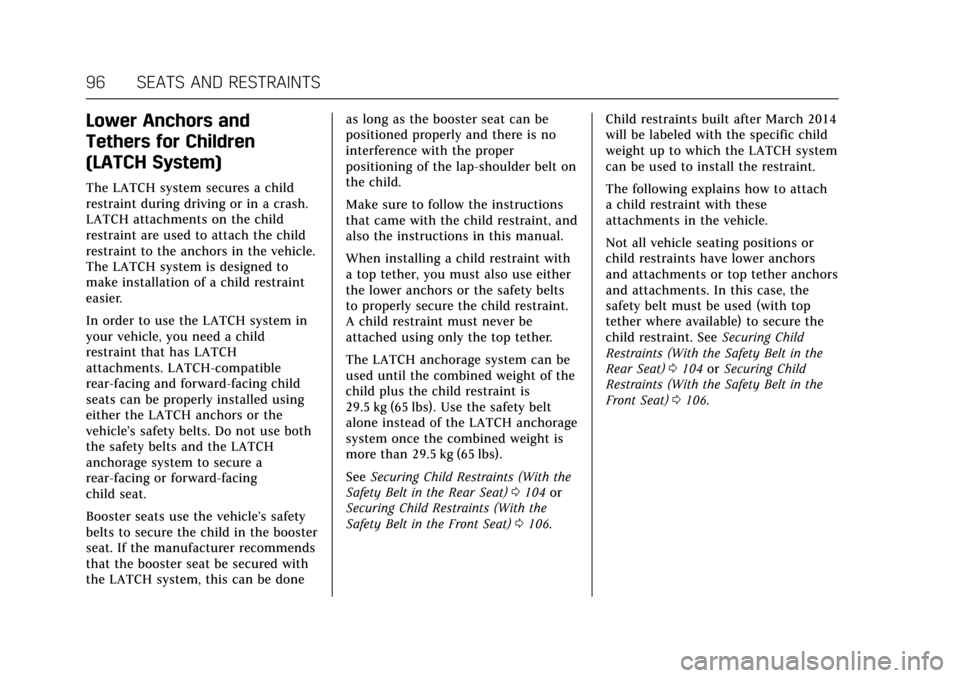
Cadillac Escalade Owner Manual (GMNA-Localizing-MidEast-10293077) -
2017 - crc - 8/24/16
96 SEATS AND RESTRAINTS
Lower Anchors and
Tethers for Children
(LATCH System)
The LATCH system secures a child
restraint during driving or in a crash.
LATCH attachments on the child
restraint are used to attach the child
restraint to the anchors in the vehicle.
The LATCH system is designed to
make installation of a child restraint
easier.
In order to use the LATCH system in
your vehicle, you need a child
restraint that has LATCH
attachments. LATCH-compatible
rear-facing and forward-facing child
seats can be properly installed using
either the LATCH anchors or the
vehicle’s safety belts. Do not use both
the safety belts and the LATCH
anchorage system to secure a
rear-facing or forward-facing
child seat.
Booster seats use the vehicle’s safety
belts to secure the child in the booster
seat. If the manufacturer recommends
that the booster seat be secured with
the LATCH system, this can be doneas long as the booster seat can be
positioned properly and there is no
interference with the proper
positioning of the lap-shoulder belt on
the child.
Make sure to follow the instructions
that came with the child restraint, and
also the instructions in this manual.
When installing a child restraint with
a top tether, you must also use either
the lower anchors or the safety belts
to properly secure the child restraint.
A child restraint must never be
attached using only the top tether.
The LATCH anchorage system can be
used until the combined weight of the
child plus the child restraint is
29.5 kg (65 lbs). Use the safety belt
alone instead of the LATCH anchorage
system once the combined weight is
more than 29.5 kg (65 lbs).
See
Securing Child Restraints (With the
Safety Belt in the Rear Seat) 0104 or
Securing Child Restraints (With the
Safety Belt in the Front Seat) 0106. Child restraints built after March 2014
will be labeled with the specific child
weight up to which the LATCH system
can be used to install the restraint.
The following explains how to attach
a child restraint with these
attachments in the vehicle.
Not all vehicle seating positions or
child restraints have lower anchors
and attachments or top tether anchors
and attachments. In this case, the
safety belt must be used (with top
tether where available) to secure the
child restraint. See
Securing Child
Restraints (With the Safety Belt in the
Rear Seat) 0104 orSecuring Child
Restraints (With the Safety Belt in the
Front Seat) 0106.
Page 98 of 354
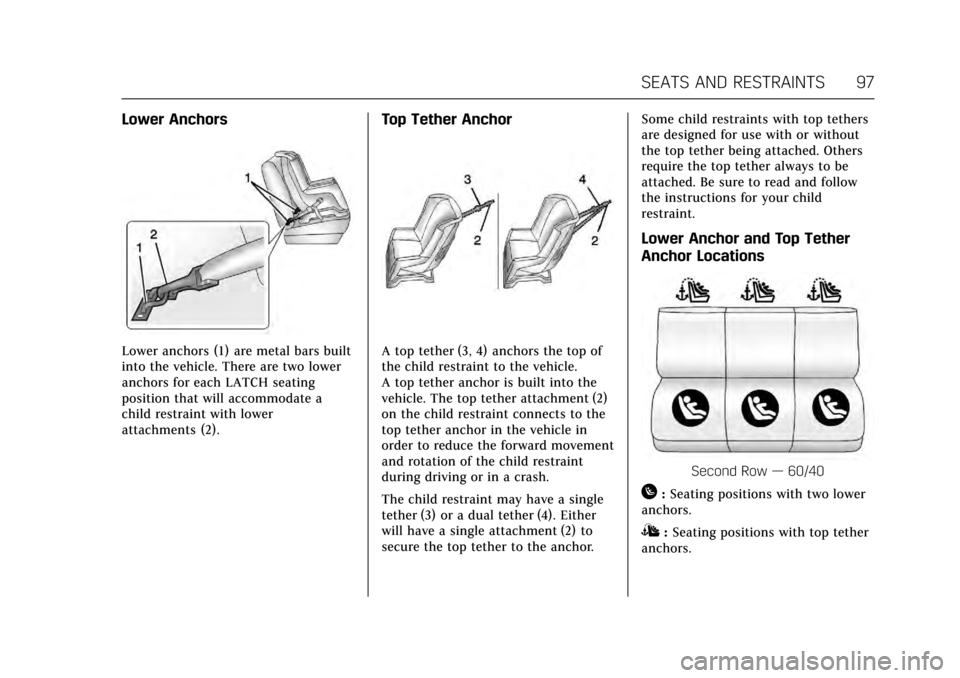
Cadillac Escalade Owner Manual (GMNA-Localizing-MidEast-10293077) -
2017 - crc - 8/24/16
SEATS AND RESTRAINTS 97
Lower Anchors
Lower anchors (1) are metal bars built
into the vehicle. There are two lower
anchors for each LATCH seating
position that will accommodate a
child restraint with lower
attachments (2).
Top Tether Anchor
A top tether (3, 4) anchors the top of
the child restraint to the vehicle.
A top tether anchor is built into the
vehicle. The top tether attachment (2)
on the child restraint connects to the
top tether anchor in the vehicle in
order to reduce the forward movement
and rotation of the child restraint
during driving or in a crash.
The child restraint may have a single
tether (3) or a dual tether (4). Either
will have a single attachment (2) to
secure the top tether to the anchor.Some child restraints with top tethers
are designed for use with or without
the top tether being attached. Others
require the top tether always to be
attached. Be sure to read and follow
the instructions for your child
restraint.
Lower Anchor and Top Tether
Anchor Locations
Second Row
—60/40
H:Seating positions with two lower
anchors.
I: Seating positions with top tether
anchors.
Page 100 of 354

Cadillac Escalade Owner Manual (GMNA-Localizing-MidEast-10293077) -
2017 - crc - 8/24/16
SEATS AND RESTRAINTS 99
row. Be sure to use an anchor on the
same side of the vehicle as the seating
position where the child restraint will
be placed.
Second Row Seat—60/40
For models with 60/40 second row
seating, the top tether anchors are at
the bottom rear of the seat cushion
for each seating position in the second
row. Be sure to use an anchor on the
same side of the vehicle as the seating
position where the child restraint will
be placed.
Third Row Seat
For the third row seat, the top tether
anchors are on the back of the
seatback. Move the flipper panel
rearward to access the anchors. Be
sure to use an anchor on the same
side of the vehicle as the seating
position where the child restraint will
be placed.
Do not secure a child restraint in a
position without a top tether anchor if
a national or local law requires that
the top tether be attached, or if the
instructions that come with the child
restraint say that the top tether must
be attached. According to accident statistics,
children and infants are safer when
properly restrained in a child restraint
system or infant restraint system
secured in a rear seating position. See
Where to Put the Restraint
095 for
additional information.
Securing a Child Restraint
Designed for the LATCH System
{Warning
If a LATCH-type child restraint is
not attached to anchors, the child
restraint will not be able to protect
the child correctly. In a crash, the
child could be seriously injured or
killed. Install a LATCH-type child
restraint properly using the
anchors, or use the vehicle's safety
belts to secure the restraint,
following the instructions that
came with the child restraint and
the instructions in this manual.
Page 101 of 354
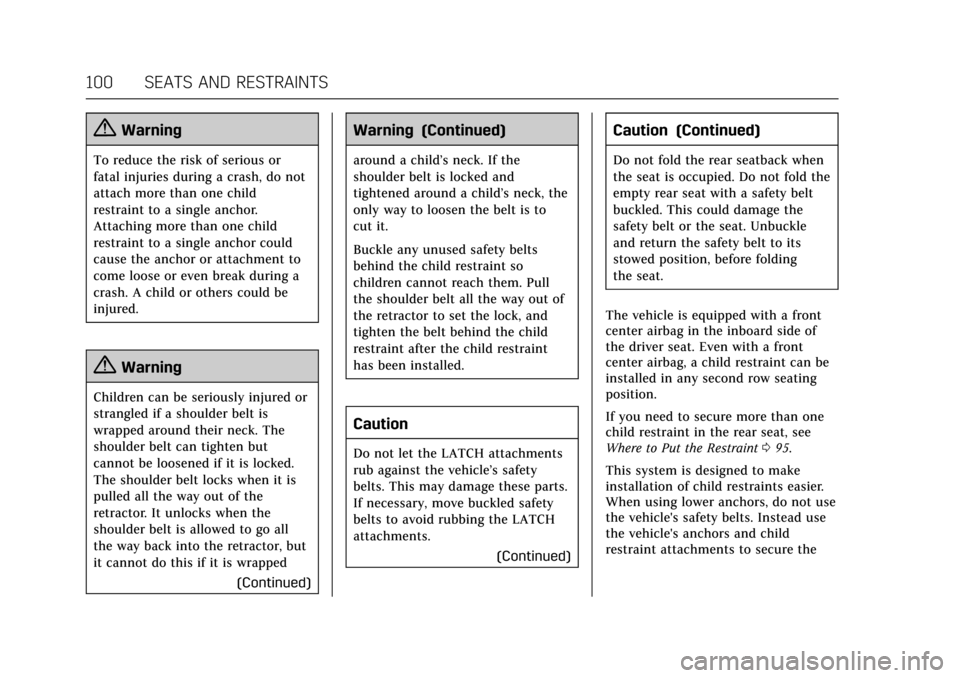
Cadillac Escalade Owner Manual (GMNA-Localizing-MidEast-10293077) -
2017 - crc - 8/24/16
100 SEATS AND RESTRAINTS
{Warning
To reduce the risk of serious or
fatal injuries during a crash, do not
attach more than one child
restraint to a single anchor.
Attaching more than one child
restraint to a single anchor could
cause the anchor or attachment to
come loose or even break during a
crash. A child or others could be
injured.
{Warning
Children can be seriously injured or
strangled if a shoulder belt is
wrapped around their neck. The
shoulder belt can tighten but
cannot be loosened if it is locked.
The shoulder belt locks when it is
pulled all the way out of the
retractor. It unlocks when the
shoulder belt is allowed to go all
the way back into the retractor, but
it cannot do this if it is wrapped(Continued)
Warning (Continued)
around a child’s neck. If the
shoulder belt is locked and
tightened around a child’s neck, the
only way to loosen the belt is to
cut it.
Buckle any unused safety belts
behind the child restraint so
children cannot reach them. Pull
the shoulder belt all the way out of
the retractor to set the lock, and
tighten the belt behind the child
restraint after the child restraint
has been installed.
Caution
Do not let the LATCH attachments
rub against the vehicle’s safety
belts. This may damage these parts.
If necessary, move buckled safety
belts to avoid rubbing the LATCH
attachments.(Continued)
Caution (Continued)
Do not fold the rear seatback when
the seat is occupied. Do not fold the
empty rear seat with a safety belt
buckled. This could damage the
safety belt or the seat. Unbuckle
and return the safety belt to its
stowed position, before folding
the seat.
The vehicle is equipped with a front
center airbag in the inboard side of
the driver seat. Even with a front
center airbag, a child restraint can be
installed in any second row seating
position.
If you need to secure more than one
child restraint in the rear seat, see
Where to Put the Restraint 095.
This system is designed to make
installation of child restraints easier.
When using lower anchors, do not use
the vehicle's safety belts. Instead use
the vehicle's anchors and child
restraint attachments to secure the
Page 102 of 354

Cadillac Escalade Owner Manual (GMNA-Localizing-MidEast-10293077) -
2017 - crc - 8/24/16
SEATS AND RESTRAINTS 101
restraints. Some restraints also use
another vehicle anchor to secure a top
tether.1. Attach and tighten the lower attachments to the lower
anchors. If the child restraint
does not have lower attachments
or the desired seating position
does not have lower anchors,
secure the child restraint with
the safety belts and top tether
when recommended by the child
restraint manufacturer. Refer to
your child restraint manufacturer
instructions and the instructions
in this manual. For the third row
outboard seating positions, if the
head restraint interferes with the
proper installation of the child
restraint, then the head restraint
may be removed. See “Head
Restraint Removal and
Reinstallation under Lower
Anchors and Tethers for Children
(LATCH System) 096.
1.1. Find the lower anchors for the desired seating
position. 1.2. Put the child restraint on
the seat.
1.3. Attach and tighten the lower attachments on the
child restraint to the lower
anchors.
2. If the child restraint manufacturer recommends that
the top tether be attached, attach
and tighten the top tether to the
top tether anchor. Refer to the
child restraint instructions and
the following steps:
2.1. Find the top tether anchor.
For the third row seat,
move the flipper panel
rearward to access the top
tether anchors.
2.2. Route, attach, and tighten the top tether according to
your child restraint
instructions and the
following instructions:
If the position you are
using does not have a head
restraint and you are using
a single tether, route the
tether over the seatback.
If the position you are
using does not have a head
restraint and you are using
a dual tether, route the
tether over the seatback.